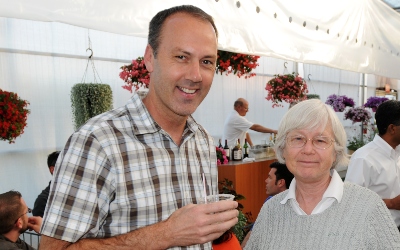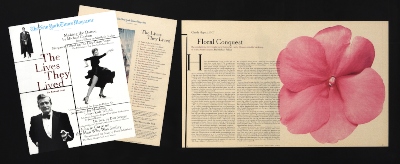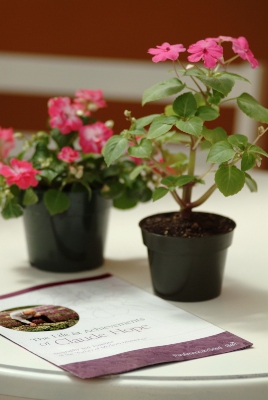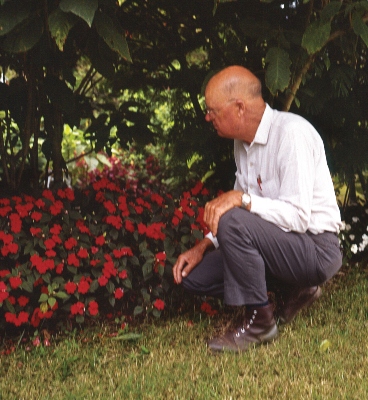As we continue our celebration of PanAmerican Seed’s 75th Anniversary, we delve into the history of our best-selling flower – Super Elfin Impatiens. We took to the experts on this subject, Mark Gross and Ellen Leue, for a Q&A on what made this series so special to so many in this industry and what does the future hold.


(Pictured L-R) Mark Gross, Account Manager – Sales and
Ellen Leue, Former Director of Research and Impatiens Breeder for PanAmerican Seed
Q: Could you provide some history on Super Elfin?
EL: The original Super Elfin series had been introduced a few years before I joined the company in 1982. Their predecessor, Elfin, had been a great success as the first commercial quality Impatiens series on the market. Claude Hope gets the credit for recognizing Impatiens as a plant with potential, and selecting more compact versions, as well as broadening the color range from the original salmon, pink and lavender of the plants that were naturalized in the coffee plantations of Costa Rica. He also found a plant with a brighter, cleaner base color and more sheen on the petals, which became the basis first for Lipstick, and then for many of the colors I bred. I was given the breeding project in 1984 and continued with it for the next 23 years.

Q: What has been the impact of the Super Elfin series of I. walleriana in the recent growth of the ornamental hort industry?
EL: Impatiens were the cornerstone of the developing pack market, which really picked up steam in the late 1970s. While many popular garden plants, like Petunias, Zinnias and African Marigolds were too lanky (at that time) for packs, Impatiens adapted well. They performed well for gardeners, too, with their shade tolerance and low fertilizer requirements, and gave them confidence that they could succeed.
But Impatiens also adapted to pots and baskets as they size up easily to fill what space they are given, so they grew as the market diversified to various container sizes. They made a solid colorful mass on the retail bench, tempting people to come give them a try, and maybe luring in first-time gardeners with their cheerful splashes of color. I think they helped grow the market overall.

Q: Why have Impatiens played such a big part of PanAmerican Seed's history?
MG: Impatiens were the #1 selling item. Nothing is better than Impatiens for color in the shade. They were the first real bedding plant for the shade and with 20+ colors available. People still talk about Lipstick and Blue Pearl because those were colors that had never been seen before.
EL: For quite a while, I think from the mid 1980s until the early 2000s, Impatiens were our biggest product. A grower’s seed order might be 30-50% Impatiens in some cases, and PanAmerican held well over half the market. Even after Wave surpassed them in dollar value, Impatiens continued for years to be the workhorse of our product line, contributing the most profit and funding the engine of customer support and the development of the many new items, such as the Fantastic Foliage, Angelonia, and many other products.
They also contributed to the overall professionalization of our seed production department. As we raised the seed quality from 85% to 90%, then to 95% yield potential, from a combination of breeding and production practices, the focus on quality helped the whole department to evolve and improve. I used to review detailed data on every variety twice a year, and discuss where further improvements needed to be made in either quality or seed yields. This entailed better data tracking, and the partnership between production and breeding to solve problems became ingrained throughout the company. Production developed extensive methodology to understand both seed yields and quality, and it benefited every product we sell.
One example was Super Elfin White. As the leading color in the series, at one point we literally produced more than a billion seeds of it per year. When the parent line, maintained by tissue culture, inexplicably plummeted in seed yield from about 22 seeds/fruit to about 4, it caused a crisis. Suddenly almost half of the production farm in Costa Rica had to be dedicated to its production, it was a sea of white flowers from greenhouse to greenhouse.
I quickly developed a replacement, which also had a slightly more compact habit and deeper green foliage, and 30 seeds/fruit. But although the germination was very good and uniform, the growers had been enjoying the (relatively) huge seeds the previous variety had started making, as there was no crowding at all in the seed pods. The seedlings of the new white were smaller and unimpressive. So again, we made a switch, and found a great compromise with the performance everyone – production, growers, gardeners – demanded.
That is still the variety we have today. But to be sure we didn't suffer the same problem again, we also instituted a system of sub-clonal tracking and performance evaluation, so we would not lose productivity on other varieties.

Q: How have Impatiens changed over the years (in terms of breeding, seed quality, supply, customer use, etc.)?
MG: In the 1970s and ‘80s, people started to move into the suburbs from the city. This influx into larger yards created an opportunity for gardening with this new population. This resulted in strong growth for Impatiens sales!
The selling of Impatiens had been growing consistently and doing well until Impatiens Downy Mildew (IDM) arrived 11 years ago. But the supply never really made it to a premium market and never reached a quart size for sale. Impatiens has always sold in packs and will continue to do so.
Now, the market will probably never be like it was pre-IDM. It’s rare to find big yards since homeowners are building bigger decks in the backyard. We’re also seeing more container gardening nowadays.
EL: We’ve tried to improve Impatiens for every user in the chain of production and use, from internal customers like seed production and inventory management, through plug and finish growers, to retailers, gardeners and landscapers. When I first started out, we worked on breeding approaches for seed quality and speed of germination, as well as making them virtually independent of needing light for germination.
That’s right, when I started, over half the varieties would not germinate well in the stacked germination rooms of some of the biggest growers. We also worked with production to develop the best grading, storage and treatment systems that improved both quality and shelf life. We dealt with issues such as Pseudomonas contamination, and thereby improved the sanitation on the farm in general. We also made big strides in improving flower size and form, compact habit, the brilliance of the colors, and the profuse flowering in the garden.
We made breakthrough new colors such as Swirl, stable star patterns, Blue Pearl, Cranberry and others. We also developed the Fiesta/Fiesta Olé double Impatiens which were a big success.
The advent of more virulent strains of downy mildew, in Europe in the mid 2000s and later worldwide, really impacted the use of Impatiens strongly. We all know how it is to live through a pandemic now! Impatiens, which had been the showpiece of so many gardens with continuous color for months on end, were suddenly defoliating and dying by mid-summer. The market contracted in a few years to a fraction of its peak, and the effort within PanAmerican to come up with a solution was intense.
Luckily, we had an active germplasm exploration/collection effort and had laid hands on some unique germplasm in east Africa that had great resistance to downy mildew. An intense breeding effort, led by Ruud Brinkkemper in Holland, quickly crossed the resistance into Super Elfin parent lines, and the Beacon Impatiens series was born.
Q: What does the future hold for the next generation of Impatiens?
MG: With Super Elfin genetics and PanAmerican Seed for producing the seed for Beacon Impatiens, we really do have a winning combination. There could be a revitalization of Impatiens, especially with newer gardeners since the pandemic. There will be nothing like pre-IDM sales, but it’s exciting to see interest, talking to customers again about our Impatiens, especially with Beacon shining the light in the shade.
EL: While we’ll never go back to the 30+ colors in the Super Elfin series at its height, I think we will see more colors converted to the durable performance of Beacon. I expect we will also see some refinements in flower size and habit as they work to eliminate the last of the “wild” traits from the resistance that is so needed in the garden.